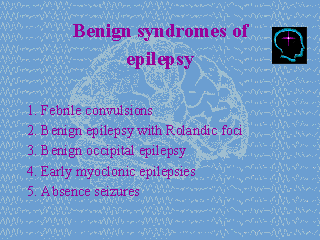|
|
|
|
front |1 |2 |3 |4 |5 |6 |7 |8 |9 |10 |11 |12 |13 |14 |15 |16 |17 |18 |19 |20 |21 |22 |23 |24 |25 |26 |27 |28 |29 |30 |31 |32 |review |
 |
Febrile convulsions occur in at least 3% of children , between the age of
6 months and 5 years . The seizure is typically generalized and occurs in
association with fevers. Intracranial infections such as meningitis must be
excluded. The risk factors for development of epilepsy as a complication of
febrile seizure include a positive family history of epilepsy, initial febrile
convulsions before 9 mo of age, a prolonged or atypical febrile seizure ,
delayed developmental milestones, and abnormal neurologic findings. The
incidence of epilepsy is 9% when several risk factors are present and 1%
in children who have no risk factors . Benign epilepsy with Rolandic foci: has an onset between 2 and 12 years, is maximal between 7 and 10, and stops by 13 years. The attacks are clonic , partially sensorimotor affecting the face, bulbal muscles, hand, and arm, and they occur particularly on waking . Benign occipital epilepsy: some children with typical partial seizures with visual phenomena, postictal headache, and migrainous characteristics have a benign prognosis, but others have a poorer cognitive and seizure outcome, and some have lesions . Early myoclonic epilepsies: separation of early myoclonic epilepsies into benign and malignant outcomes may not be possible early . Absence seizures: range from a benign self - limiting condition to part of a malignant syndrome of multiple seizure types, particularly the Lennox - Gastaut syndrome. The rate of tonic-clonic seizures in adult life, can be predicted by the expected adverse factors: history of tonic-clonic seizures, IQ< 90, and a family history of seizures. Seizures continue in about 10% of cases with no adverse factors or only one and in 100% of cases with three adverse factors. |